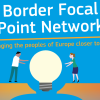The European Commission’s recent report, “EU Border Regions: Living labs of European integration”, provides an overview of the successes and challenges of integration in cross-border regions. The report takes stock of the incredible progress made in the last few years, while also reviewing issues that persist. With an eye to addressing current problems and continuing to further integration the report outlines future developments, explaining how initiatives under the new 7-year EU budget can stimulate recovery in border areas. Crucially, it is noted that cross-border cooperation must be stepped up on all fronts in order to maximise resilience in these regions and help them harness their full potential.
One of the successes that the new report celebrates is the b-solutions initiative, launched in 2018. This initiative assists public authorities in border regions address legal and administrative obstacles affecting cross-border interactions. As evidence of its success, the initiative has solved 90 cases of border obstacles across 21 Member State.

The European Commission’s recent report, “EU Border Regions: Living labs of European integration”, provides an overview of the successes and challenges of integration in cross-border regions. The report takes stock of the incredible progress made in the last few years, while also reviewing issues that persist. With an eye to addressing current problems and continuing to further integration the report outlines future developments, explaining how initiatives under the new 7-year EU budget can stimulate recovery in border areas. Crucially, it is noted that cross-border cooperation must be stepped up on all fronts in order to maximise resilience in these regions and help them harness their full potential.
One of the successes that the new report celebrates is the b-solutions initiative, launched in 2018. This initiative assists public authorities in border regions address legal and administrative obstacles affecting cross-border interactions. As evidence of its success, the initiative has solved 90 cases of border obstacles across 21 Member State.
Several projects and good practices are recounted in the report, offering evidence of tangible achievements. For example, a notable example of progress in the health sector is the Cerdanya Hospital. This hospital, on the Spanish-French border, now facilitates fast mutual recognition of qualifications for healthcare professionals. In the cultural and educational space, an initiative between Cerveiro (Spain) and Tomino (Portugal) enables the cross-border mobility of minors to carry out cultural and educational exchanges. Moreover, in the field of energy, a pioneering project is “SEREH – The Smart Energy Region of Emmen-Haren”, on the Germany-Dutch border, is developing a decentralised cross-border electricity and energy market.
Transport and infrastructure is another area where the importance of cross-border initiatives is demonstrated. Examples of current initiatives include the development of cross-border rail connectivity for the Port of Strasbourg (France); and the building of a trilateral bridge crossing river Neisse, at the German, Czech and Polish border.
EU-wide initiatives are also recognised as contributing cross-border integration. With regards to education, the European Universities Alliances (part of the Erasmus+ programme) play a key role in promoting multilingual education. Another noteworthy project is the Interreg Volunteer Youth, which has given over 500 young people the opportunity to take part in Interreg programmes and projects. Much has been done in cross-border cooperation across Europe among other things thanks to cross-border projects financed with European Regional development Fund (ERDF) under Interreg.
The report uses a public consultation carried out in 2020 to assess progress made since the 2017 Communication “Boosting Growth and Cohesion in EU Border Regions" and identify new and remaining obstacles. The 2017 Communication highlighted obstacles in border regions, specifically in health, public transport, skills recognition and legislation; and having identified the obstacles, outlined 10 actions designed to remedy them. The report concluded that public institutions must look at each cross-border region as a whole, rather than as distinct parts belonging to different Member States for innovative solutions to be implemented successfully. In addition, there is a considerable desire for the promotion of integration in these regions: 79% of respondents of the latest public consultation said that they thought EU action on cross-border integration was important because it contributes to trust-building among individuals and organisations.
These findings were used to shape the recommendations within the new report, which refocuses actions around four key clusters:
- Resilience through deeper institutional cooperation
- More and better cross-border public services
- Vibrant cross-border labour markets
- Border regions for the European Green Deal
For each cluster the report outlines the current landscape and the Commission’s planned actions to advance these goals. Actions include extending the b-solutions initiative, evaluating the Directive on Patients’ Rights in Cross-Border Healthcare, and raising awareness of the European Qualifications Framework.
This report is closely linked with the Border Focal Point Network’s fourth “Beyond Borders: Breakfast Debate” event, happening on 28th September. The online event will share the report’s title (“EU Border Regions: Living labs of European integration”) and will explore how various border regions have overcome obstacles. This event follows the successful Breakfast Debates on cross-border health, commuting and clean energy and will include the participation of officials from various EU institutions.
The full report is available here:
- Log in to post comments
- Tags
- b-solutions green deal institutional matters education employment Multilingualism health transport Information services

